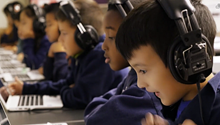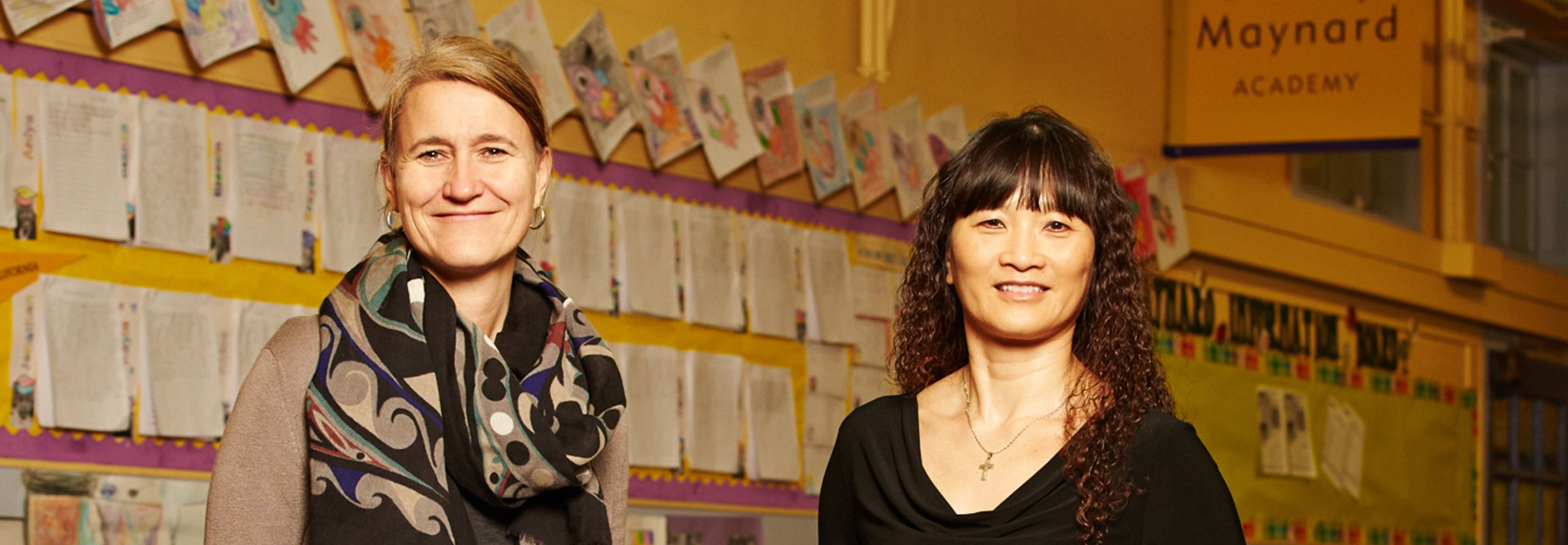Aspire's Hybrid Course Strategy Blends the Best of Online and Face-to-Face Instruction
When Liz Arney, director of innovative learning for Aspire Public Schools, a system of 38 charter schools in California and Tennessee, first considered the possibility of launching a blended learning program, she knew the benefits had to extend beyond improved access to technology.
“It wasn’t really about getting kids more opportunities to get on computers, though, yes, that was a total win,” says Arney, who helped spearhead the school system’s foray into blending learning with a pilot program in fall 2011. “We did this primarily focusing on how we can make instructional shifts to make teaching even better.”
Arney says blended learning, which combines student-controlled online learning with in-class teaching and collaboration, gives educators more time to conduct small-group work in class. Students also benefit from exposure to new technologies and increased differentiated instruction.
In the years since Aspire launched its first blended learning program, the concept has caught fire in K–12 schools. The Rise of K–12 Blended Learning, a 2011 report published by the Christensen Institute, cites research that suggests by 2019, 50 percent of high school students will take at least one online class. Less than 10 percent of those courses will be taken by students who are homeschooled or who attend a fully virtual school. That means the majority of online learning opportunities will be delivered by way of blended programs offered at traditional brick-and-mortar schools. But Arney says administrators shouldn’t adopt the approach simply because it’s popular.
Percentage of Aspire graduates accepted to a four-year college or university in the past four years. By school year 2015–2016, 14 of Aspire’s 38 schools will have incorporated blending learning
SOURCE: Evergreen Education Group, Keeping Pace with K-12 Digital Learning: An Annual Review of Policy and Practice, November 2014
“You’re not piloting blended to pilot blended. You’re hiring blended learning to solve an instructional problem,” she says.
While the concept of blended learning (sometimes called hybrid learning) is still evolving, and it undoubtedly takes many forms, Dr. Peter Cookson, principal education program researcher at the American Institutes for Research, says positive early returns have educators looking for more.
“With any new innovation, the advocates always have all these words about disruption of this and that,” says Cookson. “At the end of the day, if you’re running a school system and you’re allocating funds, you want to find the thing that has results.”
But, as educators are increasingly discovering, those results aren’t likely to come unless school districts invest in infrastructure that can adequately support a blended learning approach.
As with any new project, the process begins with planning.
Building Capacity
At Aspire, administrators started by fleshing out the mission — what they wanted teachers to be able to do (in this case, to integrate and embrace technologies that would free up class time for more collaborative work). Next, they devised a list of technologies and support services to accomplish their goals.
When Ting Vogel joined Aspire as director of technology operations, the blended learning program was already in motion, but administrators were looking to expand its reach.
Her first task? Upgrade the network.
 Learn more about Aspire's upgrade in this CDW video case study.
Learn more about Aspire's upgrade in this CDW video case study.
“We had to upgrade all the bandwidth to fiber,” Vogel explains. The existing coaxial cable network was not equipped to handle the increase in traffic that would result from widespread blended learning in classrooms.
The upgraded network package includes new Cisco switches and Meraki wireless access points, which offer a dashboard in the cloud. Vogel says the technology expands network capacity and gives administrators a system by which to monitor the network remotely, from wherever they are.
“We have sites spread across all of California,” says Vogel. “We need to be able to have every site talk to the controller, which is in the cloud.”
Another benefit of Cisco technology: It’s scalable.
“We can pretty much just add access points without having to think about upgrading the controller,” explains Vogel.
Aspire’s blended learning program is running at 12 schools. Administrators have completed network upgrades at 30 sites.
Vogel says the new technology supports the latest blended learning initiatives and builds a foundation for future technology integrations across the school system.
Support System
Technology upgrades are important, but all the hardware in the world means little unless educators have the training and support required to effectively integrate new teaching tools and methods into classroom instruction.
To help schools achieve success with the blended learning model, the school system hired teaching assistants for each site that offers the program.
The number of U.S. states (Alabama, Arkansas, Florida, Michigan and Virginia) with online learning requirements, including blended learning
SOURCE: Evergreen Education Group, Keeping Pace with K-12 Digital Learning: An Annual Review of Policy and Practice, November 2014
Arney called the decision to hire blended learning staff “the absolute most important decision we made.”
The assistants are on hand to help install classroom technology, troubleshoot hardware, provide in-class assistance for students and teachers and offer strategic advice for improving the programs.
Having the extra help “made a huge difference” in getting teachers on board with the changes, says Arney.
Training Matters
P.K. Yonge Developmental Research School, a K–12 public laboratory with ties to the University of Florida in Gainesville, started laying the groundwork for its blended learning program in 2011.
Julie Henderson, coordinator of technology, communications and international relations for the school, said educators carefully considered emerging trends in higher education and online learning before forging ahead with the program.
Statewide computer-based testing requirements already necessitated that schools upgrade their infrastructure, explains Christy Gabbard, program development and outreach specialist, so it made sense for administrators to make use of the new hardware.
Blended learning “allowed us to leverage those devices and all of that infrastructure development for something that would become ultimately more meaningful for teachers and students in the classroom,” Gabbard says.
P.K. Yonge prepared its teachers in part by adopting blended professional development. Gabbard said the part-online, part face-to-face training program “familiarized teachers with using a course management system for their own learning, so that they would be more comfortable with doing that for their own students.”
Like P.K. Yonge, administrators at Idaho’s West Ada School District were forced to upgrade school technology networks in anticipation of new statewide requirements. That plan, which would have required every high school student to take an online course prior to graduation, was eventually scrapped by the legislature, but much of the infrastructure for that program remained.
“We already had a pilot in place, so we moved forward,” says Tobey Jossis, the district’s coordinator of digital learning.
West Ada has since expanded its blended learning program.
“Expansion was never a matter of ‘if,’ ” says Dr. Eian Harm, research coordinator and innovative projects facilitator. “It was more a matter of how we’re going to make it fit.”
The district relies on a strong broadband network and capable Lenovo ThinkPad notebook devices to create a seamless face-to-face and online environment for students. Equally important is the district’s IT department, which is committed to ensuring the network works when and where teachers need it.
The Greater Goal
At their core, the best blended learning programs work because they empower teachers, says the American Institutes for Research’s Cookson.
“Teaching is a performance art,” he explains. “Kids aren’t robots — they have all sorts of needs. The class has moods.”
Cookson says blended learning should be viewed as a tool, in the same way that textbooks and lectures are tools.
“Teachers are more than technicians running computers,” he says.









